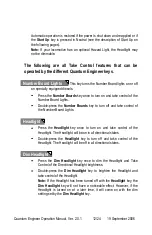
Quantum Engineer Operation Manual, Ver. 2.0.1
8/24
19 September 2006
You can use this feature to create heavy labored sounds while climbing
a grade or reduced labored sounds while descending a grade with very
little change in the speed of the train.
Dynamic Brakes
Many prototype diesel locomotives have dynamic brakes
that cause the train to slow down by using the traction motors in generator
mode. This helps dissipate the energy of a moving train by converting it to
electrical power, which is then applied to a large air-cooled resistor load in
the locomotive.
While the locomotive is operating at a steady speed, press the
Dynamic Brakes
key once to turn on the Dynamic Brakes. Hear the
Diesel Motor reduce to notch 1 followed by the sound of the powerful
diesel Cooling Fan starting up.
Double-press the
Dynamic Brakes
key to turn off the Dynamic Brakes.
Hear the Dynamic Brake Cooling Fan shut off while the Diesel Motor
returns to its original notch and Sound-of-Power setting.
Note:
If the
Dynamic Brakes
key is pressed for a steam loco, the
Chuffing will reduce to a low level and return to its previous setting
when Dynamic Brakes are shut off. This makes steam locomotive
behavior similar
12
to diesels in a consist.
Note:
In contrast to Air Brakes (F7), Dynamic Brakes do not increase
the deceleration rate specified by the Load setting in POP 2.
The
Dynamic Brakes are only a sound effect and have no actual braking
action
13
.
Note:
The Dynamic Brake function automatically turns off when
entering or leaving Neutral, or when the speed of the locomotive drops
below 7 smph
14
. The Dynamic Brakes cannot be turned on in Forward
or Reverse unless the locomotive is traveling over 8 smph. Dynamic
Brakes will not turn on if the locomotive is accelerating.
Note:
Dynamic Brakes can be turned on in Neutral if the locomotive is
in Disconnect (see note under
Locomotive State Keys
, page 15).
12
It would be unrealistic for a steam locomotive to be working at full Sound-of-Power while Dynamic Brakes are
being applied to other locomotives within the same consist.
13
Prototype dynamic brakes are commonly used on down grades with the intention of maintaining a constant
speed rather than stopping the train.
14
Dynamic Brakes on prototype diesel locomotives are seldom used at low speeds where they are less
effective.









































